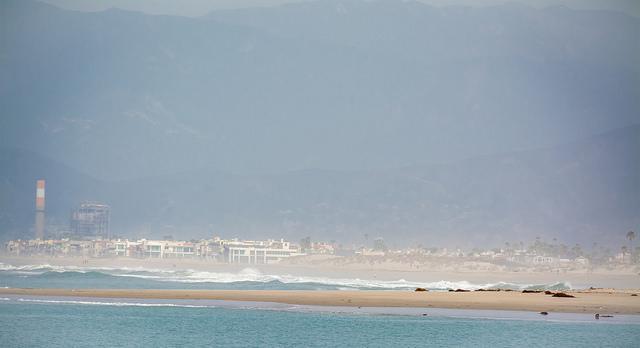
When it comes to updating your neighborhood power plant these days, nothing is certain. But for NRG, California’s largest power plant operator, that message came home last month with an odd twist: The city of Oxnard voted to place a moratorium on the construction of a plant that would replace the current structure at its oceanside location. The reason? Climate change.
Very often, shifting climate projections are used as the basis for updating facilities, like power plants, with infrastructures that may benefit from newer, greener technology or improved, sturdier structures. But in this case, the Southern California city, armed with years of objections from residents about the plant’s impact on local estuaries, saw the writing in the sand. The continued use of oceanside property for NRG’s plant meant not only the ongoing disturbance of marine life from water intake and effluent discharges, but also the real possibility of sea level changes that could impact the plant’s operation.
And then there’s the appearance issue. NRG’s Oxnard plant is one of two facilities that provide power for the county of Ventura, and it has long been considered a necessary neighbor to the growing town. But in the words of Oxnard’s Mayor pro tem Carmen Ramirez: The city is considering its future.
“These kinds of facilities would never be allowed on the coast in Santa Barbara, or Malibu, or even Ventura,” she says. “And we want to change.”
The city has placed a temporary moratorium on the construction so that residents can have a say in the decision. If it wants to extend the non-binding moratorium, it must do so within 45 days. In the meantime, the city says it is planning to hold a public hearing and reconsider the data, which includes not only the company’s own studies but also equally extensive environmental research and a map that were produced with the help of the Nature Conservancy through the Coastal Resilience project.
The map places the current power station and the proposed new plant in the middle of the coastline where the sea level rise is expected to be most dramatic. According to Coastal Resilience’s data, sea levels are expected to rise as much as 4 to 5 feet along the shoreline facing the Mandalay Bay power-generating station. Rising waters also make it more vulnerable to storm surge and flooding.
For its part, NRG said the new plant would actually benefit the climate change mitigation and takes into account various local restrictions such as plume abatement and drift and particulate emissions. It also proposes using reclaimed water rather than surface water withdrawals.
“Doing so would completely eliminate impingement and entrainment concerns, and might enable the facility to avoid possible effluent quality and permit compliance issues, depending on the quality of reclaimed water available for use,” says the report. We weren’t able to confirm by press time whether these steps would be integrated into the construction.
However, there is some question as to what steps the company could actually take to protect coastal organisms from being impacted by the plant’s water intake systems. According to NRG’s report (Chapter 5), “MGS currently withdraws its cooling water from Channel Islands Harbor. Returning any collected organisms to the harbor would be problematic.” The report also points out that it’s unlikely that organisms swept up in the intake would survive. Barrier nets likely wouldn’t be possible as well, due to the fact that the coastline is a multi-use area.
The new plant would be built south of the current facility, which also places it closer to residential areas.
While the city’s decision to impose a moratorium has been welcome news for environmental groups, it’s still unlikely to have any impact on NRG’s decision to rebuild the plant. Earlier this month, the company announced that it still plans to go ahead with the construction, and the non-binding resolution can’t actually prevent the company from doing so. Power plant construction and licensing are regulated by the California Energy Commission, which says it will be doing its own assessment and will take the environmental factors into consideration. For environmental groups like the Nature Conservancy, however, the city’s move is still a win. It means that local politicians are listening when it comes to the broader implications of climate change.
Image of Oxnard, Calif. power plant: Michelle W.
Jan Lee is a former news editor and award-winning editorial writer whose non-fiction and fiction have been published in the U.S., Canada, Mexico, the U.K. and Australia. Her articles and posts can be found on TriplePundit, JustMeans, and her blog, The Multicultural Jew, as well as other publications. She currently splits her residence between the city of Vancouver, British Columbia and the rural farmlands of Idaho.














